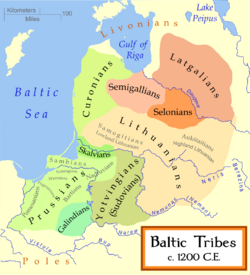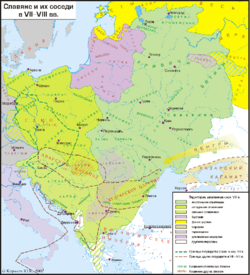Social:Galindian language
It has been suggested that this page be split into pages titled West Galindian language and East Galindian language. (Discuss) (September 2023) |
| Galindan | |
|---|---|
| Galindian | |
| Region | Northeastern Poland |
Indo-European
| |
| Language codes | |
| ISO 639-3 | xgl |
xgl | |
| Glottolog | None |

The term Galindian is sometimes ascribed to two separate Baltic languages, both of which were peripheral dialects:
- First, a West Baltic language referred to as West Galindian; and
- Second, a Baltic language previously spoken in Mozhaysk region (present day Russia), referred to as East Galindian[1]
Name
There are three proposed etymologies for the denomination Galindian:[2](pp308–309)
- Proto-Baltic *Galind- meaning 'outsider' (Lithuanian: gãlas 'wall; border').[3] This is supported by the etymology of the common Old Russian term for the Galindians Голядь Goljad' > *golędь > Baltic *Galind-);
- It is derived from the root *gal-/*gil found in Baltic hydronyms;[4][5] and
- The name means 'the powerful ones' (Lithuanian: galià 'power, strength') and also Celtic languages (Irish: gal 'strength', Welsh: gallus 'power', Galli, Gallia).[6]
Proposed relation
Based on the common name used for the two peoples by ancient authors, some scientists propose a common origin of the two peoples and languages.[2]:309[7] In order to prove this hypothesis, they investigate common features between Old Prussian/West Galindian and East Galindian.[2]:309-310
West Galindian
West Galindian is the poorly attested extinct Baltic language of the Galindians previously spoken in what is today northeastern Poland and thought to have been a dialect of Old Prussian,[2]:290 or a Western Baltic language similar to Old Prussian.[8] There are no extant writings in Galindian.
Phonology
Consonants
| Labial | Dental/ Alveolar |
Post- alveolar |
Velar | |||
|---|---|---|---|---|---|---|
| plain | pal. | |||||
| Nasal | m | n | nʲ | |||
| Plosive | voiceless | p | t | tʲ | k | |
| voiced | b | d | dʲ | dʒ | ɡ | |
| Fricative | voiceless | f | s | ʃ | ||
| voiced | z | ʒ | ||||
| Trill | r | rʲ | ||||
| Approximant | l | lʲ | j | |||
Vowels
| Front | Central | Back | ||||
|---|---|---|---|---|---|---|
| short | long | short | long | short | long | |
| High | i | iː | u | uː | ||
| Mid | eː | oː | ||||
| Mid-low | ɔ | |||||
| Low | a | aː | ||||
East Galindian
East Galindian is the poorly attested extinct Baltic language of the Balts living in the Protva Basin in present-day Russia .[2]:307
Phonology
Based on Baltic substratum and hydronomy in the Protva Basin, the following phonology can be reconstructed:[2]:311-312[9]
Consonants
| Labial | Dental/ Alveolar |
Post- alveolar |
Velar | |||
|---|---|---|---|---|---|---|
| plain | pal. | |||||
| Nasal | m | n | nʲ | |||
| Plosive | voiceless | p | t | tʲ | tʃ | k |
| voiced | b | d | dʲ | ɡ | ||
| Fricative | voiceless | s | ʃ | |||
| voiced | v | z | ʒ | |||
| Trill | r | rʲ | ||||
| Approximant | l | lʲ | j | |||
Vowels
| Front | Central | Back | ||||
|---|---|---|---|---|---|---|
| short | long | short | long | short | long | |
| High | i | iː | u | uː | ||
| Mid | eː | oː | ||||
| Mid-low | ɛ | |||||
| Low | a | aː | ||||
Lexicon
There are some Russian words from the Portva Basin region suspected to be Baltisms:[2]:312
| Russian | Transliteration | Translation | Proposed Baltic cognates |
|---|---|---|---|
| алáня | alánja | 'beer' | Lithuanian: alìnas 'special type of beer', Lithuanian: alùs, Latvian: aliņš |
| кромсáть | kromsát' | 'to break something into pieces' | Lithuanian: kramseti, Latvian: kramstīt |
| нóрот | nórot | 'fishing gear' | Lithuanian: nérti, Latvian: nērt 'to sink' |
| пикýлька | pikúl'ka | 'type of weed' | Lithuanian: pìkulė 'sisymbrium' |
References
- ↑ "galindai" (in lt). Visuotinę lietuvių enciklopediją. Mokslo ir enciklopedijų leidybos centras. https://www.vle.lt/straipsnis/galindai/. Retrieved 2022-01-28.
- ↑ 2.0 2.1 2.2 2.3 2.4 2.5 2.6 Dini, Pietro U. (2014). Foundations of Baltic languages. Vilnius: Vilniaus universitetas. ISBN 978-609-437-263-6.
- ↑ Būga, Kazimieras (1924) (in lt). Lietuvių tauta ir kalba bei jos artimieji giminaičiai. Kaunas.
- ↑ Nalepa, Jerzy (1971). "Próba nowej etymologii nazwy Galindia czyli Golędź" (in pl). Opuscula slavica 1. Slaviska och baltiska studier. 9. Lund: Slaviska institutionen vid Lunds universitet. pp. 93–115.
- ↑ Mažiulis, Vytautas (1981) (in lt). Prūsų kalbos paminklai. II. Vilnius: Mokslas. pp. 318–319.
- ↑ Schmid, Wolfgang P. (1998). "Galinder" (in de). Reallexikon der germanischen Alterskunde. 10 (2nd revised and enlarged ed.). Berlin, Boston: De Gruyter. pp. 325–327. ISBN 978-3-11-015102-2.
- ↑ Otrębski, Jan Szczepan (1958). "Zagadnienie Galindów". in Gieysztor, Aleksander (in pl). Studia Historica. W 35-lecia pracy naukowej Henryka Łowmiańskiego. Warsaw: Państwowe Wydawn. Naukowe. pp. 37–41.
- ↑ Tarasov, Iliya (January 2017). "The Balts in the migration period" (in ru). Istoričeskij Format 3-4: 95–124. https://www.academia.edu/37147068.
- ↑ Лекомцева, Маргарита Ивановна (1983). "Zur phonologischen Rekonstruktion der Goljad'-Sprache" (in de). Baltistica (Vilnius: Baltų kalbų tyrinėjimai) 19 (2): 114–119. doi:10.15388/baltistica.19.2.1591.
 |


